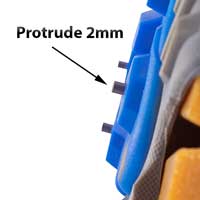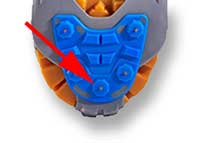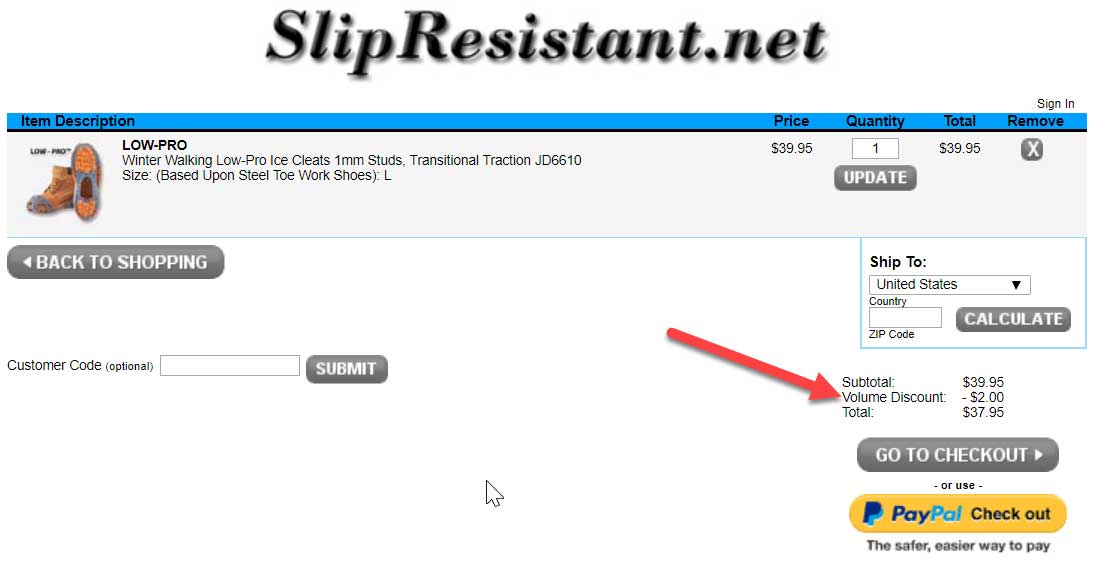Why an Ice Cleats Traction Method is Critical
12% on 6 pr. or more
Spiked (Studded) Ice Cleats
Why Spiked Ice Cleats Give You the Best Traction
Aggressive traction methods become even more critical
- in frigid temperatures when ice becomes denser. Therefore, ice cleats that work well a 28°F might not work as well or at all at 15°F. Here's another way to understand this idea. A low-quality or dull nail will work just fine for penetrating soft pine and be useless for hardwoods like oak.
- on steep hills. An ice cleat that works on flat terrain can't handle slopes with the increased g force.

Place your hand against the bottom of an ice traction device with steel coils. Now do the same, for example, with a HIGH-PRO Ice Cleat. What does your common sense tell you?
Of course the HIGH-PRO is better at penetrating ice. The traction provided by just one aggressive spike on the HIGH-PRO substantially exceeds the combined grip of the steel coils on both the right and left ice cleats.
Spike Design
Tungsten carbide spikes are uniform and remain equally aggressive and effective throughout their service life. 2mm spikes are best. 1mm spikes will give you excellent traction if they come in contact with the surface.
Number of Spikes
Spike Distribution
The spike distribution is critical since you always want at least one spike to be in contact with the ice. Spike distribution is especially critical on uneven ice. Many ice cleats are terrible in this respect.
Heel Spikes are Critical

Spike Material
Replaceable Spikes
- extend the life of the ice cleats;
- can be less comfortable because of the bump on the foot bed resulting from the mounting mechanism; and
- increase the chance of losing one or more while in use thereby increasing the chance of falling.
Ice Cleats With Replaceable Screws
Ice Cleats That Use Chains
Some chain designs have a roller barrel with edges. As the name implies, they tend to "roll" especially on flat smooth surfaces.
Chains can become a tripping hazard and can trap debris.
Wound Stainless Steel Coils
- Wound coils provide hundreds of gripping edges more than spiked ice cleats. They have to because the gripping edges are not aggressive. It takes tens if not hundreds of gripping edges to equal a single aggressive stud.
- Coiled Ice Cleats are not effective for deep snow, slush or black ice and become less effective as temperatures drop, causing ice to become denser.
- Stainless steel coils tend to wear down rapidly, especially if the user frequently walks on bare spots not covered by ice and snow. A typical user gets one season or less of use.
- While they won't damage most types of floors, you must remove this type of ice traction cleat before going indoors or on to most forms of transportation. That's because walking on a smooth, dry floor while wearing this type of ice gripper is extremely slippery and dangerous.
- Users must be careful using spike-less ice cleats in the city because they're extremely slippery when you step on a sewer grate, manhole cover or smooth, hard surface like marble or bricks.
- The initial cost is lower than professional ice cleats. However, ice cleats with steel coils require frequent replacement.
- Not suited for off-road use.
- Not suited for environments where sparking is an issue or climbing is required.



